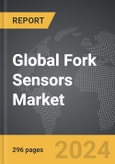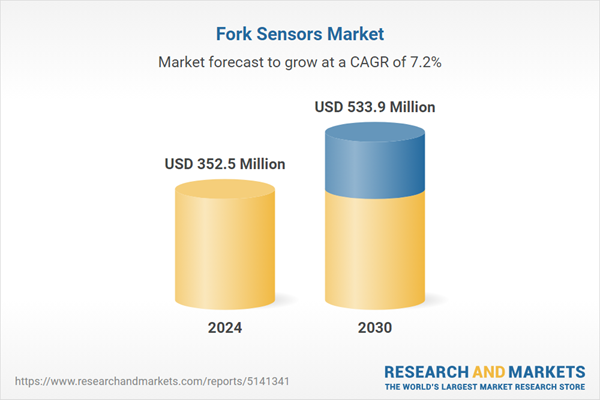The global market for Fork Sensors was valued at US$352.5 Million in 2024 and is projected to reach US$533.9 Million by 2030, growing at a CAGR of 7.2% from 2024 to 2030. This comprehensive report provides an in-depth analysis of market trends, drivers, and forecasts, helping you make informed business decisions. The report includes the most recent global tariff developments and how they impact the Fork Sensors market.
Technological advancements have significantly enhanced the capabilities and applications of fork sensors. Modern fork sensors are equipped with advanced signal processing algorithms that improve their detection accuracy and response time, even in challenging environments with high levels of dust, vibrations, or varying light conditions. The development of laser-based fork sensors has further increased their precision, enabling the detection of very small objects or fine details, such as the edges of transparent materials or tiny components in electronics manufacturing. Additionally, advancements in connectivity and integration, such as incorporating IO-Link technology, have facilitated easier configuration, diagnostics, and real-time monitoring of sensor performance, enhancing overall system efficiency and reducing downtime.
The growth in the fork sensors market is driven by several factors. The increasing automation across various industries, such as packaging, automotive, and electronics, is a significant driver, as these sectors rely on precise and reliable detection solutions to maintain high production quality and efficiency. Growth in the fork sensor market is driven by the increasing popularity and adoption of Industry 4.0 and IoT with fork sensor technology. Technological advancements in sensor design and manufacturing are making fork sensors more accurate, robust, and adaptable to a wider range of applications, encouraging their adoption. The rising demand for high-speed and high-precision manufacturing processes is also boosting the need for advanced sensing solutions like fork sensors. Additionally, the growing emphasis on reducing production errors and improving operational efficiency is driving the adoption of fork sensors in quality control and process optimization applications. Government regulations and industry standards mandating higher safety and quality standards in production processes are further supporting market growth. Together, these factors are fostering a dynamic and expanding market for fork sensors, presenting significant opportunities for innovation and development in the field of industrial automation.
Segments: Type (Optical, Ultrasonic, Vibrating Tuning); End-Use (Manufacturing, Packaging & Labeling, Other End-Uses).
Geographic Regions/Countries: World; USA; Canada; Japan; China; Europe; France; Germany; Italy; UK; Spain; Russia; Rest of Europe; Asia-Pacific; Australia; India; South Korea; Rest of Asia-Pacific; Latin America; Argentina; Brazil; Mexico; Rest of Latin America; Middle East; Iran; Israel; Saudi Arabia; UAE; Rest of Middle East; Africa.
The analysts continuously track trade developments worldwide, drawing insights from leading global economists and over 200 industry and policy institutions, including think tanks, trade organizations, and national economic advisory bodies. This intelligence is integrated into forecasting models to provide timely, data-driven analysis of emerging risks and opportunities.
Global Fork Sensors Market - Key Trends & Drivers Summarized
Fork sensors are essential components in various industrial automation and control systems, used to detect the presence or absence of objects within their sensing area. The L and U shaped fork sensors, also known as slot sensors utilize through-beam photoelectric technology for identifying objects that pass via the slot. The photoelectric sensors use light instead of sound for functioning. The rugged one-piece housing of the fork sensor maintains the alignment between the receiver and the emitter; thereby providing an appropriate single-cable connection; higher switching speeds; enhanced reliability; and ensuring fast adjustments. Fork sensors are highly valued for their accuracy, reliability, and ease of installation, making them ideal for applications such as label detection, edge guiding, counting, and positioning in packaging, printing, and material handling industries.Technological advancements have significantly enhanced the capabilities and applications of fork sensors. Modern fork sensors are equipped with advanced signal processing algorithms that improve their detection accuracy and response time, even in challenging environments with high levels of dust, vibrations, or varying light conditions. The development of laser-based fork sensors has further increased their precision, enabling the detection of very small objects or fine details, such as the edges of transparent materials or tiny components in electronics manufacturing. Additionally, advancements in connectivity and integration, such as incorporating IO-Link technology, have facilitated easier configuration, diagnostics, and real-time monitoring of sensor performance, enhancing overall system efficiency and reducing downtime.
The growth in the fork sensors market is driven by several factors. The increasing automation across various industries, such as packaging, automotive, and electronics, is a significant driver, as these sectors rely on precise and reliable detection solutions to maintain high production quality and efficiency. Growth in the fork sensor market is driven by the increasing popularity and adoption of Industry 4.0 and IoT with fork sensor technology. Technological advancements in sensor design and manufacturing are making fork sensors more accurate, robust, and adaptable to a wider range of applications, encouraging their adoption. The rising demand for high-speed and high-precision manufacturing processes is also boosting the need for advanced sensing solutions like fork sensors. Additionally, the growing emphasis on reducing production errors and improving operational efficiency is driving the adoption of fork sensors in quality control and process optimization applications. Government regulations and industry standards mandating higher safety and quality standards in production processes are further supporting market growth. Together, these factors are fostering a dynamic and expanding market for fork sensors, presenting significant opportunities for innovation and development in the field of industrial automation.
Report Scope
The report analyzes the Fork Sensors market, presented in terms of units. The analysis covers the key segments and geographic regions outlined below.Segments: Type (Optical, Ultrasonic, Vibrating Tuning); End-Use (Manufacturing, Packaging & Labeling, Other End-Uses).
Geographic Regions/Countries: World; USA; Canada; Japan; China; Europe; France; Germany; Italy; UK; Spain; Russia; Rest of Europe; Asia-Pacific; Australia; India; South Korea; Rest of Asia-Pacific; Latin America; Argentina; Brazil; Mexico; Rest of Latin America; Middle East; Iran; Israel; Saudi Arabia; UAE; Rest of Middle East; Africa.
Key Insights:
- Market Growth: Understand the significant growth trajectory of the Optical segment, which is expected to reach US$254.9 Million by 2030 with a CAGR of a 7.9%. The Ultrasonic segment is also set to grow at 6.8% CAGR over the analysis period.
- Regional Analysis: Gain insights into the U.S. market, valued at $77.7 Million in 2024, and China, forecasted to grow at an impressive 8.5% CAGR to reach $65.1 Million by 2030. Discover growth trends in other key regions, including Japan, Canada, Germany, and the Asia-Pacific.
Why You Should Buy This Report:
- Detailed Market Analysis: Access a thorough analysis of the Global Fork Sensors Market, covering all major geographic regions and market segments.
- Competitive Insights: Get an overview of the competitive landscape, including the market presence of major players across different geographies.
- Future Trends and Drivers: Understand the key trends and drivers shaping the future of the Global Fork Sensors Market.
- Actionable Insights: Benefit from actionable insights that can help you identify new revenue opportunities and make strategic business decisions.
Key Questions Answered:
- How is the Global Fork Sensors Market expected to evolve by 2030?
- What are the main drivers and restraints affecting the market?
- Which market segments will grow the most over the forecast period?
- How will market shares for different regions and segments change by 2030?
- Who are the leading players in the market, and what are their prospects?
Report Features:
- Comprehensive Market Data: Independent analysis of annual sales and market forecasts in US$ Million from 2024 to 2030.
- In-Depth Regional Analysis: Detailed insights into key markets, including the U.S., China, Japan, Canada, Europe, Asia-Pacific, Latin America, Middle East, and Africa.
- Company Profiles: Coverage of players such as Schneider Electric SE, Omron Corporation, Rockwell Automation, Inc., Pepperl + Fuchs Vertrieb Deutschland GmbH, Omega Engineering, Inc. and more.
- Complimentary Updates: Receive free report updates for one year to keep you informed of the latest market developments.
Some of the 31 companies featured in this Fork Sensors market report include:
- Schneider Electric SE
- Omron Corporation
- Rockwell Automation, Inc.
- Pepperl + Fuchs Vertrieb Deutschland GmbH
- Omega Engineering, Inc.
- IFM Electronic GmbH
- Balluff GmbH
- Leuze Electronic GmbH + Co. KG
- SensoPart Industriesensorik GmbH
- Baumer Electric AG
- Di-Soric GmbH & Co. KG
- Powelectrics Ltd.
- M.D. Micro Detectors SpA
- Sapcon Instruments (P) Ltd.
- Photon Controls India Pvt., Ltd.
Tariff Impact Analysis: Key Insights for 2025
Global tariff negotiations across 180+ countries are reshaping supply chains, costs, and competitiveness. This report reflects the latest developments as of April 2025 and incorporates forward-looking insights into the market outlook.The analysts continuously track trade developments worldwide, drawing insights from leading global economists and over 200 industry and policy institutions, including think tanks, trade organizations, and national economic advisory bodies. This intelligence is integrated into forecasting models to provide timely, data-driven analysis of emerging risks and opportunities.
What’s Included in This Edition:
- Tariff-adjusted market forecasts by region and segment
- Analysis of cost and supply chain implications by sourcing and trade exposure
- Strategic insights into geographic shifts
Buyers receive a free July 2025 update with:
- Finalized tariff impacts and new trade agreement effects
- Updated projections reflecting global sourcing and cost shifts
- Expanded country-specific coverage across the industry
Table of Contents
I. METHODOLOGYMII. EXECUTIVE SUMMARY2. FOCUS ON SELECT PLAYERSIII. MARKET ANALYSISSOUTH KOREAREST OF ASIA-PACIFICARGENTINABRAZILMEXICOREST OF LATIN AMERICAIV. COMPETITION
1. MARKET OVERVIEW
3. MARKET TRENDS & DRIVERS
4. GLOBAL MARKET PERSPECTIVE
UNITED STATES
CANADA
JAPAN
CHINA
EUROPE
FRANCE
GERMANY
ITALY
UNITED KINGDOM
SPAIN
RUSSIA
REST OF EUROPE
ASIA-PACIFIC
AUSTRALIA
INDIA
LATIN AMERICA
MIDDLE EAST
AFRICA
Companies Mentioned (Partial List)
A selection of companies mentioned in this report includes, but is not limited to:
- Schneider Electric SE
- Omron Corporation
- Rockwell Automation, Inc.
- Pepperl + Fuchs Vertrieb Deutschland GmbH
- Omega Engineering, Inc.
- IFM Electronic GmbH
- Balluff GmbH
- Leuze Electronic GmbH + Co. KG
- SensoPart Industriesensorik GmbH
- Baumer Electric AG
- Di-Soric GmbH & Co. KG
- Powelectrics Ltd.
- M.D. Micro Detectors SpA
- Sapcon Instruments (P) Ltd.
- Photon Controls India Pvt., Ltd.
Table Information
| Report Attribute | Details |
|---|---|
| No. of Pages | 296 |
| Published | April 2025 |
| Forecast Period | 2024 - 2030 |
| Estimated Market Value ( USD | $ 352.5 Million |
| Forecasted Market Value ( USD | $ 533.9 Million |
| Compound Annual Growth Rate | 7.2% |
| Regions Covered | Global |









